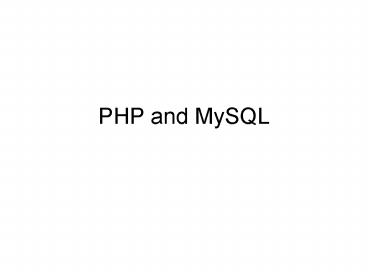PHP and MySQL - PowerPoint PPT Presentation
1 / 25
Title:
PHP and MySQL
Description:
Get list of all the entries in joe's (user 22) shopping cart: ... Takes care of the logic for adding an item to the shopping cart for current user. ... – PowerPoint PPT presentation
Number of Views:1095
Avg rating:3.0/5.0
Title: PHP and MySQL
1
PHP and MySQL
2
MySQL
- Open Source database server
- Runs on many platforms (Unix Windows)
- Networked server no fancy GUI like MS Access.
- You can find clients that provide a GUI.
- Great for small to medium-sized applications
3
MySQL Installation/Configuration
- You install the server, and provide a root
password. - Now you need a client to do anything!
- Create databases, view databases, etc.
- Windows MySQL server comes with a command-line
client - You need to learn all the commands, and type them
in manually
4
phpMyAdmin
- A MySQL client written in PHP
- Via the web you can manage
- Manage Databases
- Manage MySQL users
- Submit queries (SQL)
- A great way to learn SQL!
5
Php MySQL Support
- You need a version of PHP that includes the MySQL
module - Included by default on most php distributions.
- Documentation of all mysql functions/objects is
available via php.net.
6
Opening a MySQL database
- usernamefred passwordfred
- databaseeiw
- mysql_connect("localhost",username,password)
- _at_mysql_select_db(database) or die( "Unable to
select database") - Assumes that the machine running the server is
localhost - You can easily use a MySQL server that is running
on a remote machine.
7
Submitting a query to the server
- query "SELECT uid from users WHERE username
fred" - res mysql_query(query)
- // no result - no user so return false
- if (! res)
- no result (error!)
8
Using the results of a query
- In ASP/ODBC we used a recordset object to access
the results of a query. - Mysql_query returns something similar an object
we can use to get at the rows of the result of
the query.
9
Accessing
- mysql_numrows(res) number of rows in the
result. - mysql_result(res,index,field)
- Returns a single column value
- index is the row
- field is the field name (column name)
10
Example
- res mysql_query(SELECT FROM users)
- if (! res) handle error
- numrows mysql_numrows(res)
- for (i0i
- name mysql_result(res,i,username)
- pass mysql_result(res,i,password)
- Do something with name and password
11
Sample Code
- Simple e-commerce site
- Users login in (with just a user name)
- View products (including search)
- Add products to shopping cart
- Remove products from shopping cart
12
Database Tables
- users information about all the customers that
use the system. - products information about all the products we
sell. - cartentries shopping cart items (relates a user
to a product)
13
Table users
- uid integer id number (autoincrement)
- firstname, lastname strings. varchar(20)
- username string login name. varchar(20)
- email string. varchar(30)
14
Table products
- pid integer id number (autoincrement)
- name string product name. varchar(30)
- price floating point number.
15
Table cartentries
- uid integer user id number
- pid integer product id number
- quantity integer ( products).
16
Some Queries
- Get list of all products
- SELECT FROM products
- Get list of all the entries in joes (user 22)
shopping cart - SELECT FROM cartentries WHERE uid22
- Check the actual code in the demo for more
complex queries
17
Sample Code main.php
- main.php the main program
- takes care of the session (session variable
userid) - Determines what the query is and takes
appropriate action. - Many actions defined in other PHP files that are
included using require - Generates the base HTML for the document
(including a small header).
18
Database Code db.php
- php functions that interact with the database.
This file is always required by main.php. - Creates connection to the mysql server.
- Functions login, product_list, show_cart,
add_to_cart, remove_from_cart and some HTML
generating functions.
19
add.php
- Called from main.php when user is adding an item
to cart - require(add.php)
- Takes care of the logic for adding an item to the
shopping cart for current user. - Makes sure item exists.
20
login.php
- Called from main.php when user is trying to log
in - require(login.php)
- Takes care of the logic for login process
- Decides what to send back if valid/invalid login.
21
logout.php
- Called from main.php when user is trying to log
out - require(logout.php)
- Takes care of the logic for log out
- Terminates the session.
22
plist.php
- Called from main.php when user wants to see a
list of products - require(plist.php)
- Just calls product_list function provided by
db.php
23
remove.php
- Called from main.php when user is trying to
remove an item from shopping cart - require(remove.php)
- Gets user id (from session) and product id (from
HTTP query) - Calls remove_from_cart
- Sends back resulting cart as HTML.
24
search.php
- Called from main.php when user is trying to
search for products - require(search.php)
- If a search query is found in the HTTP query,
processes the search. - If no search query found, sends back a form that
can be used to submit a search.
25
show.php
- Called from main.php when user is trying to see
their shopping cart in - require(show.php)
- Just calls show_cart function found in db.php

